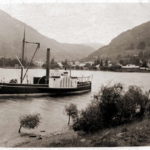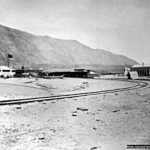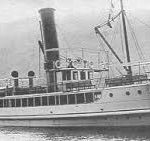With the gold rush there was a need for some form of regular transport between Kingston and Queenstown. The coastal shores were too rugged for roading and it wasn’t until 1936 that a road was completed between Kingston and Queenstown. Until then there was just a walking and pack horse track around the south-east bank under the Remarkables.
Lake Wakatipu is New Zealand’s third largest lake, after Lake Taupo and Lake Te Anau. It covers some 290 square kilometres. It is an elongated S-shaped lake some 77 km long with Glenorchy at the headwaters, Kingston at the southern end, and New Zealand’s major skiing and tourist location, Queenstown, in the centre. The lake is 310 metres (1,016 feet) above sea level, with its greatest depth being 380 metres, and, at 45° latitude, it lies half way between the equator and the South Pole.

The first boat to regularly ply Lake Wakatipu was a whaleboat purchased by sheep farmer and explorer William Rees (of Rees Valley fame) in 1860. He needed a boat to ship his wool out of the district. The whaleboat was purchased from Bluff (Campbelltown) and hauled by bullock sledge to Kingston. On arrival the bullocks were put on board and taken to the new station at Queenstown Bay. Once gold was discovered in the Shotover in 1862, the Rees boat, called Undine, was used heavily for transport of people and supplies. This boat had the honour of carrying the first consignment of gold, some 25,000 ounces, out of the Wakatipu gold diggings. At today’s gold prices that one shipment was worth more than 36 million US dollars (55 million New Zealand dollars)!
With the 1860s gold rush giving a boost to the region, other boats were soon in demand. Two private firms were established to build and run steamers on the lake, followed by a number of other companies later on.
In the early years, wood was the main source of fuel for the paddle steamers and for domestic and commercial heating. Ships were kept busy carting firewood to Queenstown, and that is one of the reasons why there are no big trees around the Kingston area today.
In addition to many sailing craft, a number of steamers were brought to Lake Wakatipu, mostly from Dunedin. Steamers in the early to mid-1860s included the Expert, Victoria, Wakatip, and the Nugget. The Nugget (later renamed the Alexandra), was shipped from Melbourne in 1862, cut into two and transported by bullock wagon to Kingston, assembled and launched within three days.
The Moa was another boat built at the time, in 1863. It was designed for Captain John Kerr, who became the owner of the Ship Inn, the local storekeeper, postmaster, and shipping agent. He subsequently purchased the section, built and was proprietor of the Terminus Hotel, which later was renamed as the Lake Wakatipu Hotel, and owned by Helena Selwood. At that time, virtually any price could be commanded for passenger and freight fares. Passengers on the Moa were charged £3 per head from Kingston to Queenstown.
The first of the long-lived series of lake steamers was the wooden paddle steamer Antrim. This was built at Greenstone on the western shores of Lake Wakatipu from local timber and launched in 1868. Initially a wood-burner, it was converted to coal-fired boilers in 1885.
The Ben Lomond, initially called Jane Williams, was another famous steamer of that time. It was launched at Queenstown in 1872. It established regular daily services up and down the lake. The Ben Lomond carried 131 passengers and had a cargo capacity of 25 tons. It was privately owned and operated until 17 April 1903 when it was purchased by the government and operated by the New Zealand Railways. It was withdrawn from service in 1951, at 80 years of age, and, at the time, was the oldest steamer on Lloyd’s register. It was sunk in Kingston Bay in 1952.
Once the railway line from Invercargill to Kingston was completed in 1878 there was an upsurge in tourist traffic. The paddle steamer Mountaineer was built in Dunedin and conveyed by rail in sections to Kingston where it was assembled and launched on 11 February 1879. It could carry 200 passengers and 30 tons of freight. It too was purchased and operated by the government in 1903. It was sold in 1932 as a houseboat at Walter Peak Station and scrapped in 1941.
The introduction of the Mountaineer service by the newly-formed Wakatip Steam Shipping Company resulted in a price war with the other major company, Messrs J.W. Robertson & Co., the owners of Antrim and Jane Williams (Ben Lomond). The Wakatip Steam Shipping Company was also in dispute with the Postmaster-General regarding the contract for carrying mail, and reduced their sailings to a thrice weekly service. The somewhat inevitable result of this was the liquidation of the Wakatip Steam Shipping Company in 1882. The Mountaineer continued under new ownership.
By 1899 there was growing general dissatisfaction with the excessive charges made by the Lake Wakatipu Steam Shipping Company which was by this stage the monopoly transporter on the lake. A Lake County Council deputation went to the Premier, Hon Richard Seddon. The government had wanted to increase the patronage on the Kingston line, particularly during the summer months, but the high shipping charges were apparently deterring travel. The government purchased the Lake Wakatipu Shipping Company and took possession on 3 November 1902.
Despite the government purchase there was still much dissatisfaction with the service, particularly regarding comfort. The Ben Lomond in particular gathered a bad reputation. Through 1905 to 1909 there were deputations to parliamentarians to improve the service.
In August 1909 the government announced that a new boat would be built for Lake Wakatipu. The following is the progress of the building of this twin-screw coal-fired steamer of 330 tons designed to carry over 1,000 passengers:
September 1910 – Tender let for building to Messrs J. McGregor and Co., Dunedin
4 July 1911 – Keel laid at McGregor’s Dunedin yard
October 1911 – Announced that the ship would be called the TSS Earnslaw
3 November 1911 – Last plate bolted onto the framing at Dunedin
November 1911 – Disassembled and parts railed to Kingston
28 November 1911 – Keel laid at Kingston
14 December 1911 – Last frame in position
24 February 1912 – Launching of the Earnslaw
2 April 1912 – Funnel and mast placed in position
3 August 1912 – First trial trip under steam, as far as Half Way Bay
23 August 1912 – Second trial
18 October 1912 – Inaugural sailing of the Earnslaw
21 October 1912 – New Zealand Railways formally accept delivery and enters service
All the assembly, launching, fitting out, trialling, and the maiden voyage took place when Helena Selwood was proprietor of the sole hotel and Kingston. It was where many of the ship builders stayed, shared stories, and enjoyed the hostelry social scene.
Indeed, some of the Selwood children helped build the Earnslaw! Florence Pullar, grand-daughter of Helena, told the story of her mother, Rose, about 22 at the time, being invited by the Kingston ship-builders to place some of the rivets in their holes prior to hot riveting. It must have been an exciting time for the Selwood family when the Earnslaw was assembled there. There was a labour shortage at Kingston in building the Earnslaw and it is quite possible that the younger Selwood males may have been employed on assembling the vessel. Eldest son was definitely there, because according to his son, Neville, his Dad gave up Nokomai gold mining for a period to work on the assembly of the Earnslaw.
One often repeated Selwood story by the next generation of descendants was that Helena Selwood launched the Earnslaw. This is explored further in a later section.
At the time of launching the Ben Lomond was in attendance and took the new steamer in tow to the Kingston wharf for fitting out. The partnership of the Ben Lomond and the Earnslaw that started on this occasion lasted 40 years until the Ben Lomond’s hull, on its last journey to Kingston, was finally scuttled in the deep waters of the lake near Kingston in 1952.
It was a very special day on Friday 18 October 1912 at Kingston with the inaugural sailing of the Earnslaw. A special train from Dunedin and Gore joined up with an even larger afternoon train from Invercargill at Lumsden and travelled to Kingston. They arrived at 5pm. There was no time for any quick refreshments at Helena Selwood’s adjacent Lake Wakatipu Hotel because the Earnslaw was all steamed up and ready to go. The bunting decked-out Earnslaw left for Queenstown a few minutes later to the accompaniment of the Invercargill Highland Pipe Band. There were many dignitaries on board including the Minister of Railways, Mr J. Miller, who was very instrumental in advocating the improved Lake Wakatipu shipping service. It was a quick trip to Queenstown and there was a large crowd to welcome its arrival. It was a joyous occasion in town that night.
The next day was a public holiday in Queenstown allowing many to travel on the Earnslaw all-day trip to the head of the lake at Glenorchy where the official welcomes, toasts and a buffet lunch were held on board. To the north of the lake could be seen the 2,800 metre Mt Earnslaw after which the ship was named. Mt Earnslaw is now part of the Mount Aspiring National Park.
For part of the return journey, the Earnslaw was put to full speed and reached Queenstown in one hour and fifty minutes, some one hour faster than previous ferries.
With the inaugural sailings being very successful, New Zealand Railways accepted the Earnslaw within days and it entered regular services on the lake. It served the run-holding sheep stations on the shores of the lake for decades, carrying sheep, bales of wool, and vehicles. In 1968 the Earnslaw was very nearly scrapped. Sense prevailed and in 1969 she was leased to Fiordland Travel (now called Real Journeys) who, in 1982, purchased the Earnslaw and continues to successfully run it as a tourist venture, mainly between Queenstown and Walter Peak Station.
Before concluding this chapter it should be mentioned that a small plaque today marks the location where the steamship Earnslaw and the Mountaineer, 33 years previously, were assembled and first launched.
The Earnslaw is now entering its 11th decade and is the oldest running coal-fired steam ship running regular services in the Southern Hemisphere. Its longevity has a lot to do with the pure fresh waters of Lake Wakatipu. During one annual survey the only corroding plates that needed replacement were due to soap and detergent spillage in the toilet!
Today the Earnslaw works 14 hours a day through the summer months and cruises 11 months of the year – a remarkable ship with which the Selwood family has had close early association. Long may the “Lady of the Lake” continue!
VIDEO LINKS
Paddle steamer Antrim, 1868: www.nzmaritime.co.nz/antrim.htm
Steamer Ben Lomond, 1872: www.nzmaritime.co.nz/lomond.htm
Paddle steamer Mountaineer, 1879: www.nzmaritime.co.nz/mountaineer.htm
Twin screw steamship Earnslaw, 1912: www.nzmaritime.co.nz/earnslaw.htm








